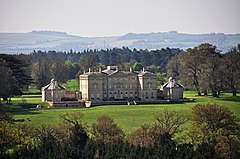Buckland, Oxfordshire
| Buckland | |
|---|---|
 St Mary the Virgin parish church |
|
 Buckland House with a wooded escarpment which mark one edge of the parish before the Vale of the Ock (White Horse) and the North Wessex Downs visible beyond . |
|
| Buckland shown within Oxfordshire | |
| Area | 18.23 km2 (7.04 sq mi) |
| Population | 588 (parish, including Gainfield) (2011 Census) |
| • Density | 32/km2 (83/sq mi) |
| OS grid reference | SU3498 |
| Civil parish |
|
| District | |
| Shire county | |
| Region | |
| Country | England |
| Sovereign state | United Kingdom |
| Post town | Faringdon |
| Postcode district | SN7 |
| Dialling code | 01367 |
| Police | Thames Valley |
| Fire | Oxfordshire |
| Ambulance | South Central |
| EU Parliament | South East England |
| UK Parliament | |
Buckland is a village and large civil parish about 4 miles (6.4 km) northeast of Faringdon in the Vale of White Horse District. Buckland was part of Berkshire until the 1974 boundary changes transferred it to Oxfordshire. The 2011 Census recorded the parish's population as 588.
The River Thames forms the northern boundary of the parish, just over 1 mile (1.6 km) north of the village. St Mary the Virgin parish church is at grid reference SU342982 and Buckland House at grid reference SU338981.
The soil of the parish is a rich, sandy loam on a geology of Corallian Limestone and Oxford Clay.
Buckland's toponym evolved through spellings that include Boclande in the 10th century,Bocheland in the 11th century, Bochelanda in the 12th century, and Boclonde, Bokeland and Bikeland in the 13th century.
The earliest known record of Buckland is from AD 957 in a charter in which King Edgar the Peaceful granted Ælfheah ten hides of land at Buckland. In the reign of Edward the Confessor (1042–1066) Ulvric Chenp held the manor of Buckland. The Domesday Book of 1086 lists Buckland as part of the lands of Bishop Osbern of Gamesfel Hundret (now called Gainfield). However, his right was not established and the case had already been sent before King William the Conqueror. The estate was assessed as eight hides and consisted of a mill, four fisheries and a dairy farm producing 10 wheys of cheese a year. Its value was given as £8.
...
Wikipedia

